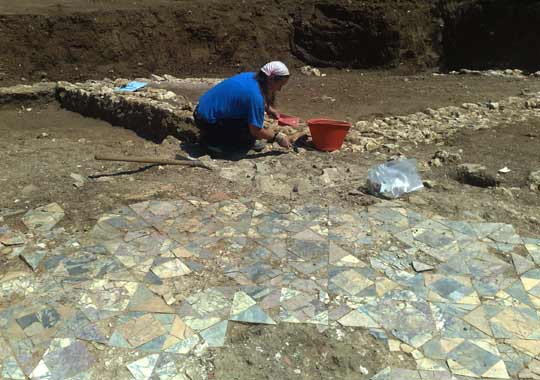
An archaeologist works on the site of Roman Emperor Vespasian's summer villa. Titus Flavius Vespasianus, the emperor who ordered the construction of the Colosseum, ascended to the throne at the ripe old age of 60 and remained emperor until his death at age 69
Titus Flavius Vespasianus is known for rebuilding the Roman Empire following the tumultuous reign of Emporer Nero. Vespasian changed the face of Rome by launching a major public works program, which included the construction of the Colosseum, the structure that arguably defines the glory of ancient Rome.
Dating back to the first century A.D., the massive villa, adorned with mosaic floors, baths and marbled halls, has emerged following four years of digs near the town of Cittareale, in the province of Rieti.
The villa not only is located near the place of Vespasian's birth at Falacrinae (Vicus Phalacrinae), but also may be the site where he is said to have died.
"We are talking of a unique, 15,000-square-meter (161,459-square-foot) villa. We found no inscription that says it belonged to the emperor, but the location, dating, size and quality of the building leave little doubt about its owner," Filippo Coarelli, the archaeologist of the University of Perugia who led the excavation, told Discovery News.
According to the archaeologists, Vespasian might have built his sumptuous summer house near his birthplace to show off his wealth and power.
"The exact location of Falacrinae has long been the subject of debate. We now know that this village of ancient Rome lay near Cittareale, " Pierluigi Feliciangeli, the mayor of Cittareale, told Discovery News.
Indeed, the rediscovery near Cittareale of an ancient Roman inscription celebrating a Falacrinae resident at the Social War in 91-88 B.C., has made it possible to identify the ancient village.
In a parallel dig, archaeologists found the remains of Falacrinae -- tombs, vases, and various artifacts which are now on display at the Cittareale museum.
"We have Falacrinae and we have this huge villa. It all points to Vespasian. This is an incredible finding for Cittareale," Feliciangeli said.
According to Coarelli, the most spectacular section of the villa is the floor of the main hall, made of polychrome marbles quarried in North Africa. Two other rooms have delicate mosaic floors.
"Indeed, this is an exceptional finding," Coarelli said.



Reader Comments
to our Newsletter